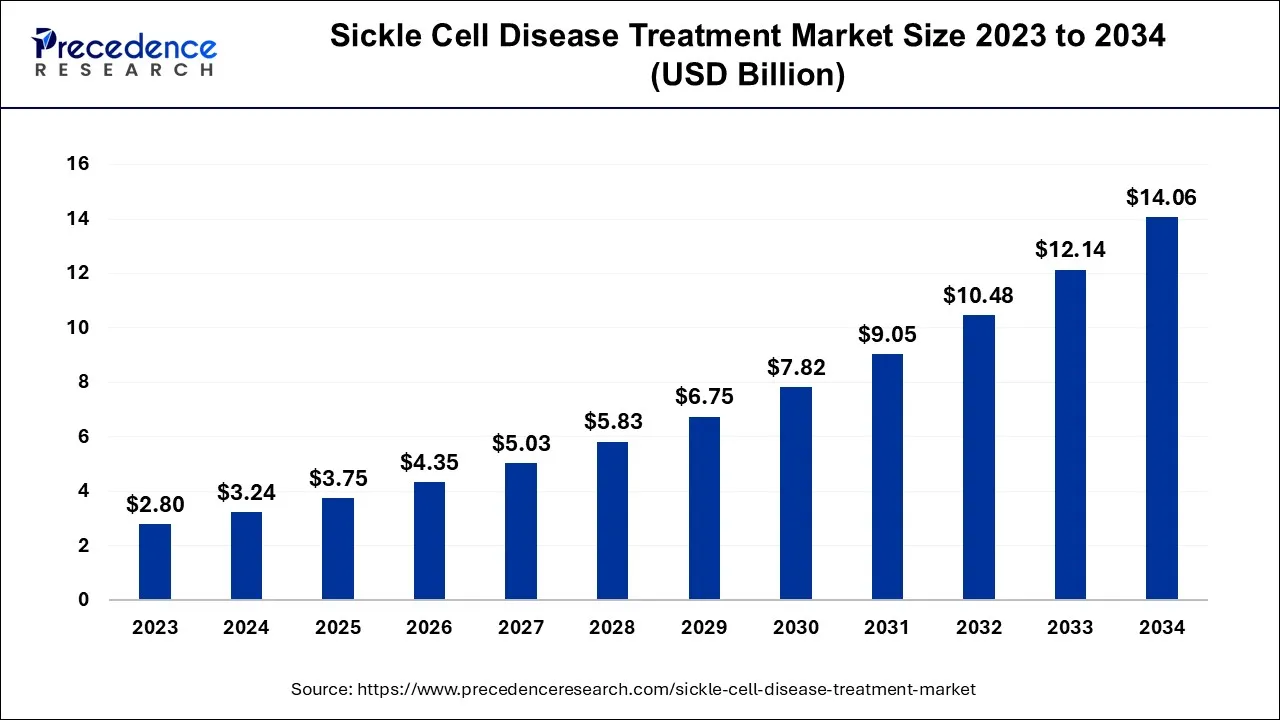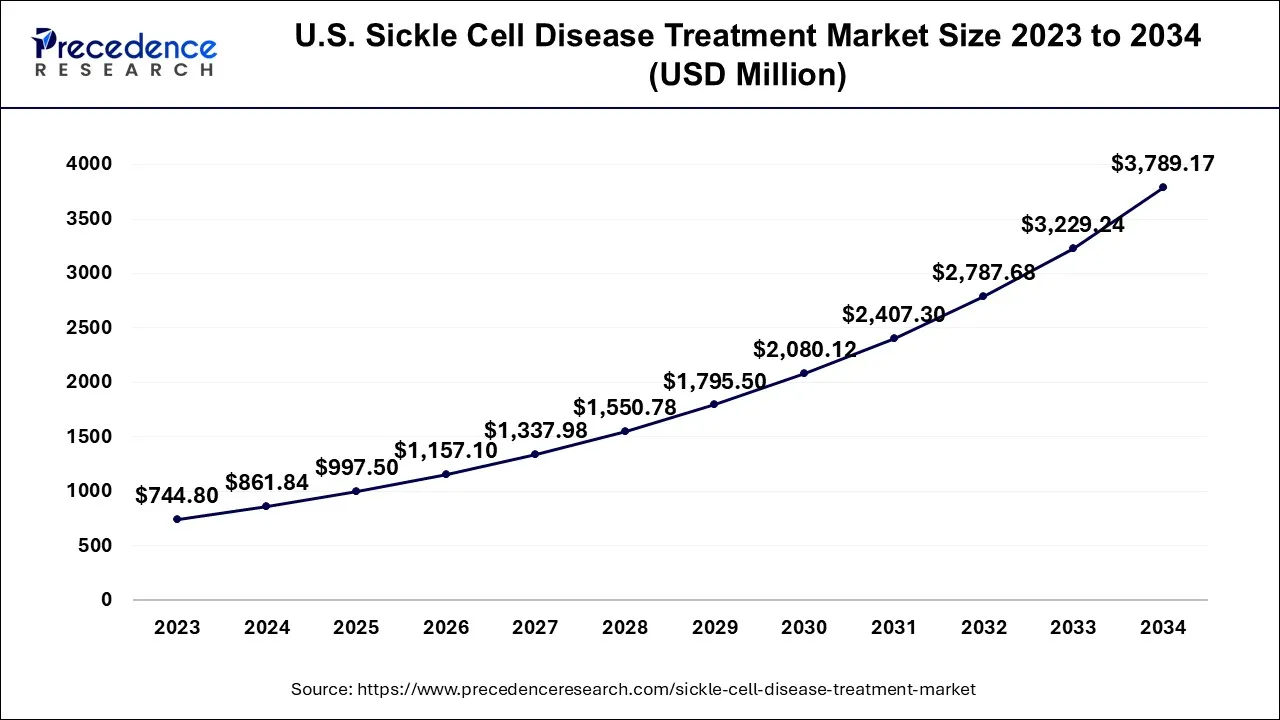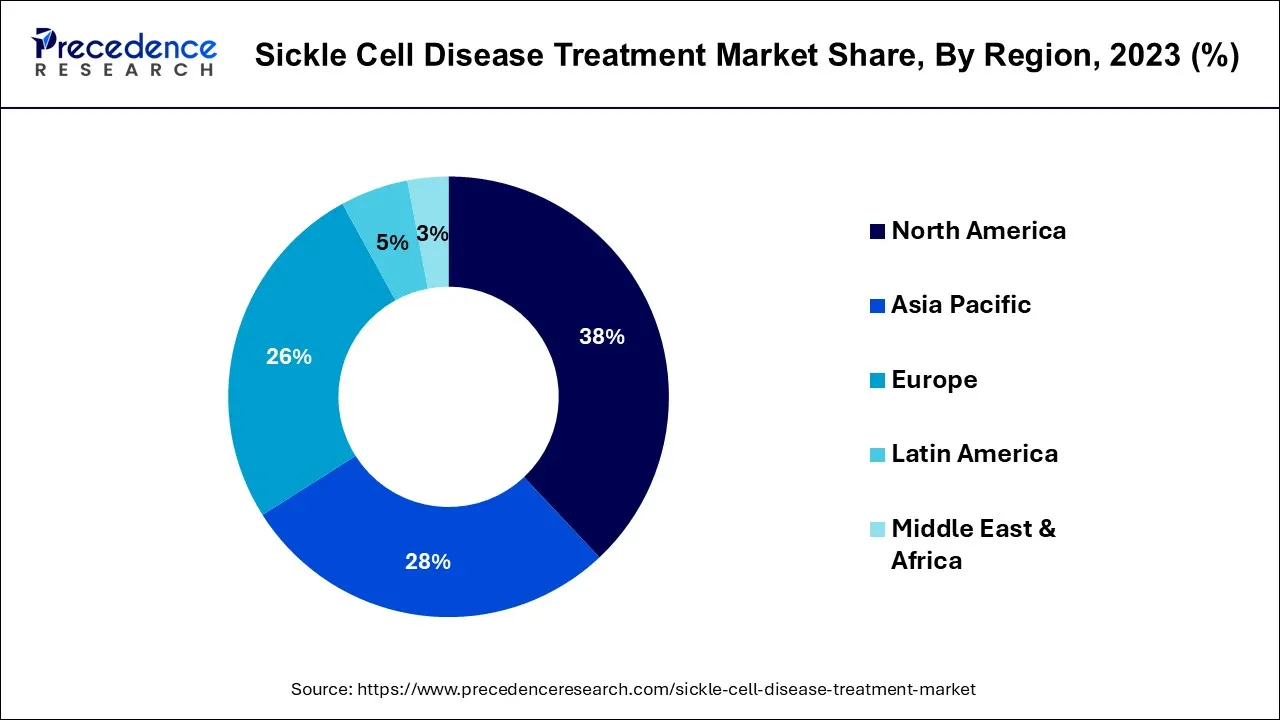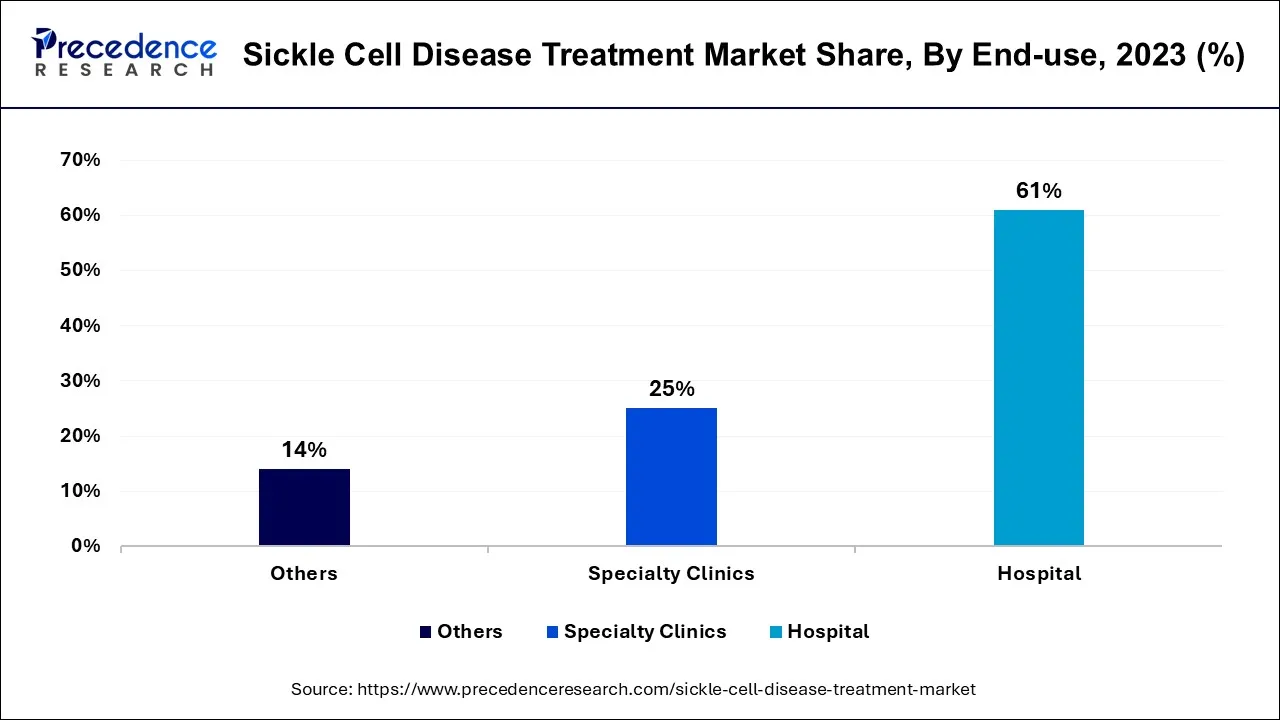February 2025
The global sickle cell disease treatment market size is calculated at USD 3.24 billion in 2024, grew to USD 3.75 billion in 2025, and is predicted to hit around USD 14.06 billion by 2034, expanding at a CAGR of 15.8% between 2024 and 2034. The North America sickle cell disease treatment market size accounted for USD 1.23 billion in 2024 and is anticipated to grow at the fastest CAGR of 15.96% during the forecast year.
The global sickle cell disease treatment market size is expected to be valued at USD 9.82 billion in 2024 and is anticipated to reach around USD 14.06 billion by 2034, expanding at a CAGR of 15.8% over the forecast period from 2024 to 2034.

The U.S. sickle cell disease treatment market size accounted for USD 861.84 million in 2024 and is projected to be worth around USD 3,789.17 million by 2034, poised to grow at a CAGR of 15.99% from 2024 to 2034.

North America has held the largest revenue share 36% in 2023. This region has seen an increasing emphasis on comprehensive care and improved access to treatments. Specialized SCD clinics and centers of excellence have become more prevalent, providing multidisciplinary care to patients. Moreover, Participation in clinical trials and research is increasing, with an emphasis on creating curative remedies such as gene editing. Telemedicine has gained traction, enhancing access to care, particularly in remote or underserved areas. These trends reflect a commitment to advancing SCD treatment, addressing disparities, and improving the overall quality of life for patients in North America.

Asia-Pacific is estimated to observe the fastest expansion. In this region, trends in the sickle cell disease (SCD) treatment market are evolving. While the prevalence of SCD is lower compared to some other regions, there is a growing recognition of the need for improved diagnosis and treatment. Advancements in healthcare infrastructure and increased awareness of SCD are driving early diagnosis efforts.
However, access to specialized care and curative therapies remains a challenge in many parts of the region. Telemedicine adoption, bolstered by the COVID-19 pandemic, is helping bridge some of these gaps. Additionally, collaborations between healthcare providers, governments, and pharmaceutical companies are contributing to research and the development of more effective treatments tailored to the Asia-Pacific population.
Sickle cell disease is a genetic blood disorder that causes misshapen red blood cells, leading to pain, anemia, and organ damage. Treatment aims to manage symptoms and complications. Common interventions include pain relief with analgesics, hydration, and blood transfusions to improve oxygen levels. Hydroxyurea, a medication, can help reduce the frequency of painful crises. For severe cases, a bone marrow transplant is a potentially curative option. Patients also derive benefits from routine check-ups, vaccinations, and antibiotics to prevent infections. Education on self-care, including managing triggers such as dehydration and extreme temperatures, is vital for enhancing the quality of life for individuals with sickle cell disease.
The sickle cell disease (SCD) treatment market is experiencing notable growth, driven by various factors and industry trends. Sickle cell disease is a genetic blood disorder characterized by misshapen red blood cells, leading to pain, anemia, and organ damage. One of the significant growth drivers is the continuous advancement in therapies. The emergence of gene-editing techniques like CRISPR-Cas9 holds promise for potential cures, stimulating increased research and development activities in the field. Increased awareness of sickle cell disease is a significant catalyst driving market growth. This growing recognition of sickle cell disease's prevalence, particularly in specific regions, has generated a heightened emphasis on early diagnosis and treatment.
Consequently, this increased awareness has triggered greater investments and initiatives geared towards improving the quality of life for individuals affected by the disease. Government support plays a pivotal role in driving the industry. Many governments have initiated programs and provided incentives to boost research efforts, enhance access to treatment, and address the challenges associated with SCD. These governmental efforts are particularly prominent in regions where the burden of sickle cell disease is substantial.
Moreover, the market's expansion is propelled by emerging economies that have historically faced constraints in accessing comprehensive healthcare services. In these regions, there is currently an upswing in investments in healthcare infrastructure and the diversification of treatment options, which is playing a substantial role in driving the overall expansion of the market. However, the industry faces its share of challenges. High treatment costs associated with novel therapies can limit access for some patients and strain healthcare systems.
Furthermore, the challenge of ensuring equal access to healthcare and addressing the unique requirements of diverse patient demographics persists as a hurdle in the quest for effective sickle cell disease treatment. Nonetheless, the industry is well-positioned for ongoing growth and innovation, dedicated to enhancing the well-being of individuals afflicted by SCD.
| Report Coverage | Details |
| Growth Rate from 2024 to 2034 | CAGR of 15.8% |
| Market Size in 2024 | USD 3.24 Billion |
| Market Size by 2034 | USD 14.06 Billion |
| Largest Market | North America |
| Base Year | 2023 |
| Forecast Period | 2024 to 2034 |
| Segments Covered | By Treatment and By End-use |
| Regions Covered | North America, Europe, Asia-Pacific, Latin America, and Middle East & Africa |
Expanded access to healthcare and advancements in therapies
Expanded access to healthcare has significantly surged the demand for sickle cell disease treatment. Improved healthcare infrastructure, increased availability of medical facilities, and enhanced accessibility to specialized care have led to earlier diagnoses and more comprehensive management of sickle cell disease.
As a result, a larger patient population seeks treatment, driving up demand for therapies, medications, and supportive care services. This expansion in the patient base not only benefits affected individuals but also boosts market growth as pharmaceutical companies and healthcare providers respond to the rising need for effective treatments and therapies for sickle cell disease.
Moreover, Advancements in therapies, particularly the development of innovative treatments such as gene therapies and disease-modifying drugs, have ignited significant demand in the sickle cell disease treatment market. These breakthroughs promise enhanced symptom management, reduced complications, and potential cures, driving patient and physician interest.
As these therapies demonstrate effectiveness and safety, they instill greater confidence among healthcare providers and patients, leading to increased adoption and market growth. Moreover, ongoing research and development efforts further fuel the market's expansion as the pursuit of improved treatments remains at the forefront of addressing the challenges associated with sickle cell disease.
Limited treatment options and limited awareness
The limited treatment options available for sickle cell disease restrain market demand by restricting the range of therapeutic choices for both patients and healthcare providers. With only a handful of treatments, especially curative options, patients often face a lack of comprehensive care. This limitation also hinders healthcare systems' ability to address the diverse needs of individuals with the disease. Consequently, the market's growth potential is hampered with the challenge of addressing the complex and varied requirements of sickle cell disease management.
Moreover, limited awareness poses a significant restraint on the sickle cell disease treatment market. Insufficient awareness also hinders research funding and public health initiatives, impeding progress in treatment development and the overall growth of the market. Addressing this awareness gap is crucial to ensuring that patients receive timely and appropriate care.
Improving access to care and developing curative therapies
Improving access to care in the sickle cell disease treatment market significantly boosts demand. Enhanced access means more patients can receive timely diagnosis and treatment, increasing the patient pool. This, in turn, drives greater demand for therapies, medications, and healthcare services. As accessibility expands, healthcare providers and institutions are more likely to invest in treating sickle cell disease, while pharmaceutical companies are incentivized to develop and market new treatments.
Ultimately, improving access to care not only benefits patients but also fuels market growth by addressing an underserved healthcare need. Moreover, the development of curative therapies has significantly surged the demand in the sickle cell disease treatment market. These innovative treatments hold the promise of not just managing symptoms but offering potential cures, transforming the outlook for patients.
The prospect of a definitive solution has intensified patient and physician interest, driving the market's growth. As these therapies prove their effectiveness and safety, they foster greater confidence, prompting increased adoption and market expansion. The pursuit of curative options represents a critical turning point in addressing the longstanding challenges of sickle cell disease treatment.
According to the Treatment, the blood transfusion segment has held 49.5% revenue share in 2023. Blood transfusion, a crucial treatment for sickle cell disease (SCD), involves the infusion of healthy red blood cells to replace the abnormal sickle-shaped ones. In the SCD treatment market, a trend toward more targeted and less frequent transfusions has emerged. This approach aims to reduce iron overload, a common complication of regular transfusions, by using erythrocytapheresis, a specialized technique. Additionally, efforts are underway to enhance donor diversity and improve blood compatibility for better patient outcomes, reflecting ongoing advancements in SCD care.
The bone marrow transplant segment is anticipated to expand at a significant CAGR of 42.8% during the projected period. A bone marrow transplant, also known as a hematopoietic stem cell transplant, is a medical procedure where damaged or abnormal bone marrow is replaced with healthy stem cells. In the sickle cell disease (SCD) treatment market, this curative therapy has gained prominence as it offers the potential for a definitive cure. Recent trends show an increasing focus on optimizing the transplant process, including developing less toxic conditioning regimens, improving donor matching, and enhancing post-transplant care. These trends aim to make bone marrow transplantation safer and more accessible to a broader range of SCD patients.
Based on the End-use, the hospital segment held the largest market share of 61% in 2023. Hospitals play a central role in the sickle cell disease (SCD) treatment market as key end-users. These healthcare institutions provide comprehensive care for SCD patients, ranging from diagnosis and acute crisis management to long-term disease management and specialized treatments. In recent trends, hospitals are increasingly adopting telemedicine solutions to improve accessibility for SCD patients, especially during the COVID-19 pandemic.
Furthermore, some hospitals are participating in clinical trials for advanced therapies, contributing to ongoing research and the development of potential cures for SCD. Hospitals remain pivotal in addressing the evolving needs of SCD patients and driving advancements in treatment options.

On the other hand, the Specialty clinics segment is projected to grow at the fastest rate over the projected period. Specialty clinics are healthcare facilities that exclusively focus on diagnosing, managing, and providing specialized care for individuals with SCD. These clinics offer comprehensive services, including regular check-ups, pain management, transfusions, and access to clinical trials. Trends in the SCD treatment market indicate a growing emphasis on the establishment of specialized SCD clinics. These clinics aim to centralize expertise, improve patient outcomes, and enhance the quality of care. They also facilitate easier access to emerging treatments and therapies, contributing to a more holistic and patient-centric approach to managing this genetic blood disorder.
Segments Covered in the Report
By Treatment
By End-use
By Geography
For inquiries regarding discounts, bulk purchases, or customization requests, please contact us at sales@precedenceresearch.com
No cookie-cutter, only authentic analysis – take the 1st step to become a Precedence Research client
February 2025
January 2025
January 2025
January 2025